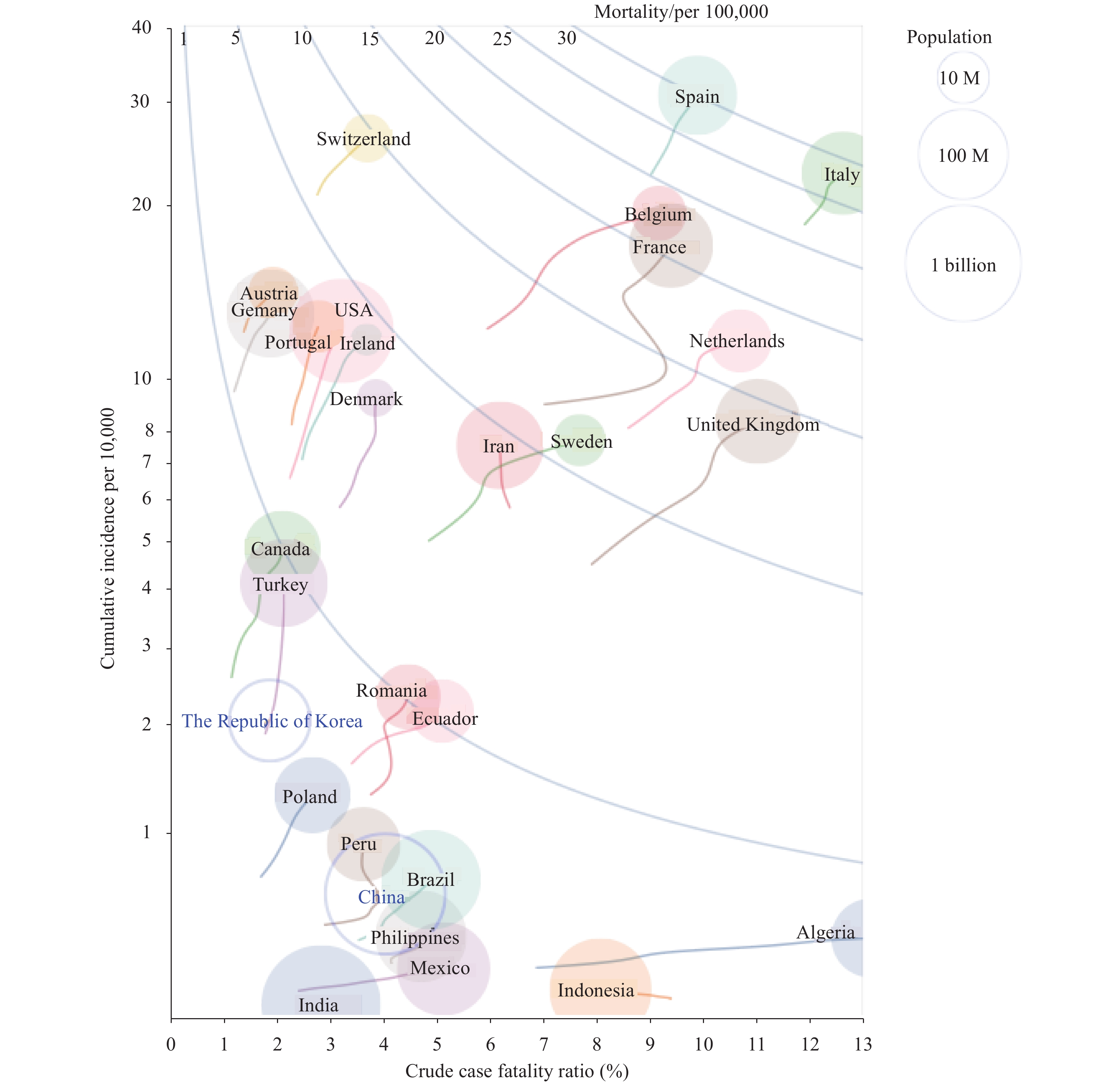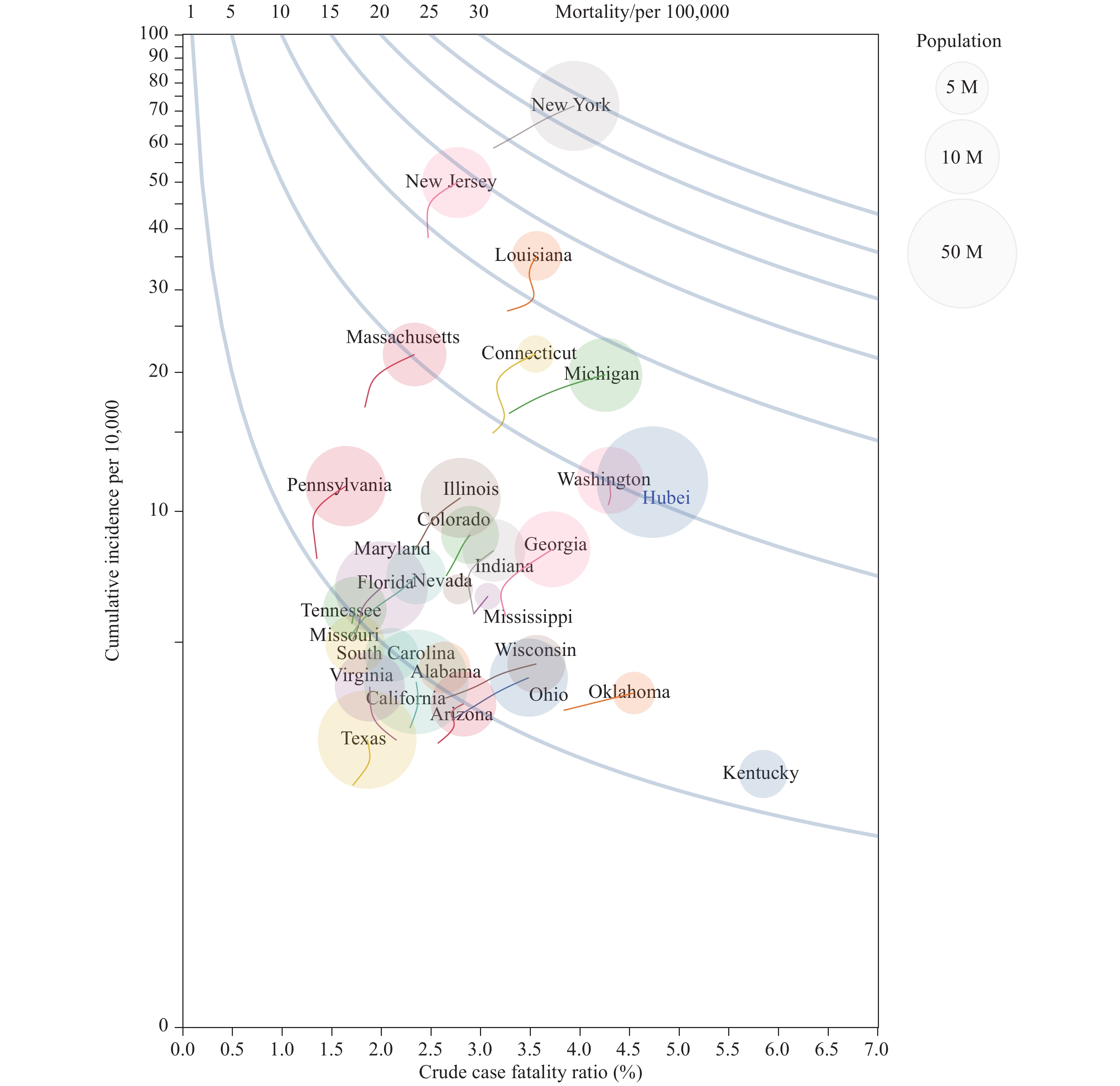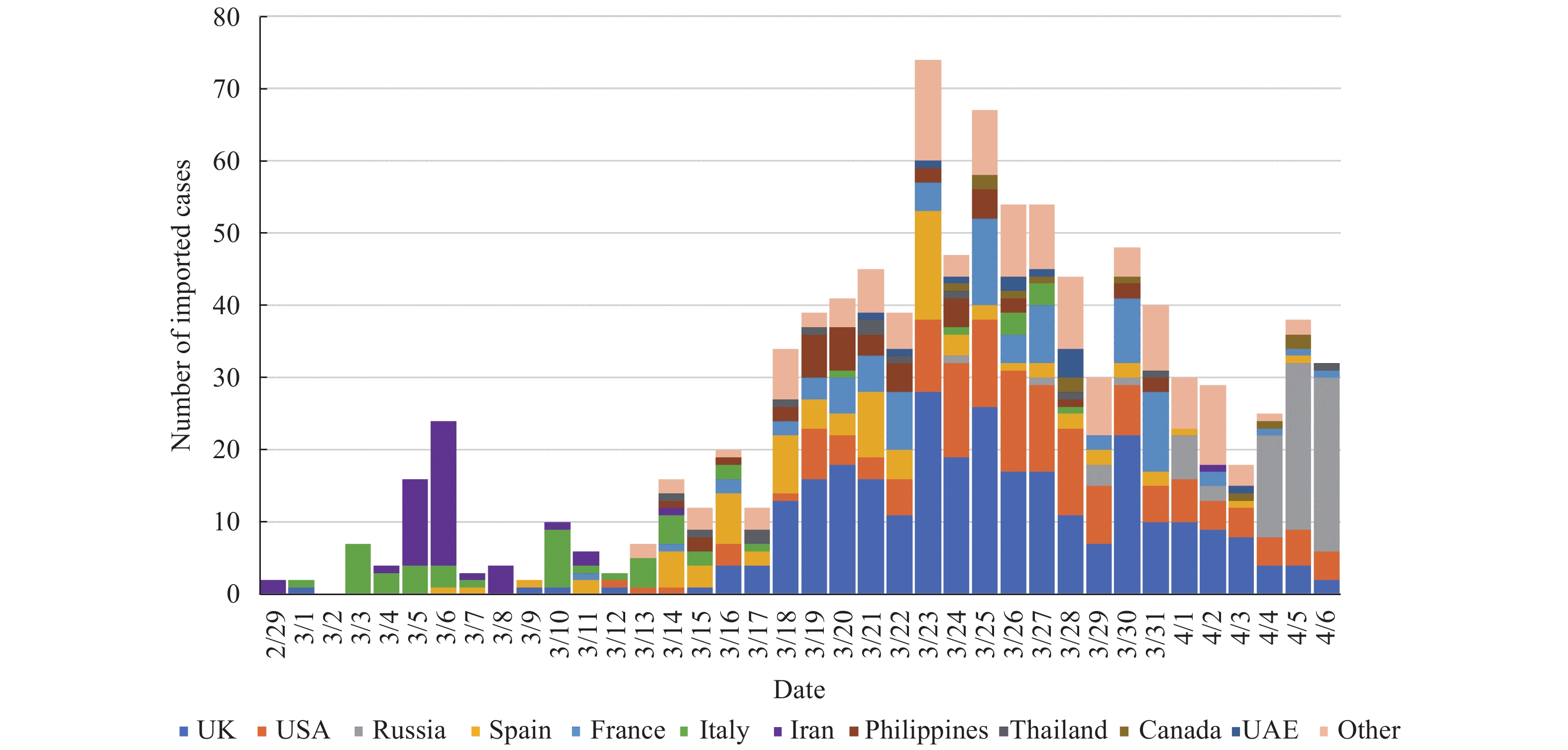-
In the past 7 days, COVID-19 continued rapidly spreading worldwide. According to the World Health Organization (WHO) website, by 10:00 CET on April 7, 2020, 209 foreign countries and territories on 6 continents plus the Diamond Princess international cruise ship reported 1,196,651 confirmed cases and 69,274 deaths; among them, 178 countries and territories were confirmed to have local transmission. Cumulatively, the WHO website reported 30,570 confirmed COVID-19 cases from 18 countries and territories in the Western Pacific (excluding China), 686,338 cases from 60 countries and territories in Europe, 9,132 cases from 10 countries and territories in South-East Asia, 78,565 cases from 21 countries and territories in the Eastern Mediterranean, 384,242 cases from 53 countries and territories in the Americas, and 7,092 cases from 47 countries and territories in Africa (1).
In this report, using the public data of COVID-19 on internet, particularly the data from April 2 to 9, 2020, the pandemic was analyzed globally and by country. The current COVID-19 epidemic in the USA was reviewed. The risk of case importation into China was also evaluated.
-
Similar to the report last week, dozens of countries with fatal confirmed cases over 100 by April 8 were selected. As shown in Figure 1, the crude case fatality ratio (CFR, total deaths/total cases) and the cumulative incidence (CI, total cases/total population) of each country were calculated and illustrated on the X-axis and the Y-axis, respectively. Compared with the data in the last report (March 26 to April 1) (2), more countries were included. Spain and Italy moved from the mortality zone of 20–25 deaths/100,000 to that of 25–30 deaths/100,000 in the past 7 days with very high CFRs and CIs. Belgium and France moved relatively faster from the zone of 5–10 deaths/100,000 to that of 15–20 deaths/100,000. The Netherlands were located in the zone of 10–15 deaths/100,000. Switzerland, the UK, and Sweden were located in the zone of 5–10 deaths/100,000, in which Switzerland had a markedly higher CI and the UK had a higher CFR. Austria, Germany, Portugal, USA, Ireland, Denmark, and Iran were still located at the zone of 1–5 deaths/100,000, showing rapidly increasing CI but slowly increasing CFR. Romanian and Ecuador entered this zone from that of 0–1 deaths/100,000 in the past 7 days. The other 12 countries were located at the zone of 0–1 deaths/100,000, including China and the Republic of Korea. Algeria showed rapidly increasing CFR, while Canada and Turkey revealed rapidly increasing CI.
 Figure 1.
Figure 1.Comparisons of the COVID-19 crude case fatality ratio (X axis = total deaths/total cases), cumulative incidence (Y axis = total cases/total population), and mortality (the isoline = total deaths/total population) of 29 countries with more than 100 fatal cases by April 8, 2020. The size of the balloon was proportional to the country's population size. The small rope of the balloon traced the history of changes related to CI and CFR in the past 7 days. M=million.
-
Countries with more than 1,000 confirmed cases by April 7 were selected and the individual average daily growth rates (cumulative cases in one day/cumulative cases in the previous day) were calculated, which were showed in Figure 2 with different colors based on geographic region. Belarus showed the highest average daily growth rate but a small number of cumulative cases, while Turkey kept a high growth rate with a large number of cumulative cases in the past two weeks. Western European countries generally contained more cumulative cases, but some Eastern European countries such as Russia, Belarus, Ukraine, and Serbia had higher growth rates. Regarding Western European countries with large populations and more cumulative cases, the UK and France had relatively higher growth rates (in the region of 10%–20% rate) than Spain, Germany, and Italy (in the region below 10%). USA, containing the largest number of cumulative cases, still had a high growth rate, while other counties in North and South America, such as Canada, Mexica, Brazil, Peru, and Chile, also had high growth rates. Besides China and the Republic of Korea where the COVID-19 pandemic was largely controlled, the numbers of the cumulative cases in the majority of Asian countries were relatively fewer. However, the daily growth rates in India and the Philippines were high. More attention should be paid to countries with large population in Asia and South America in the next few weeks.
-
The COVID-19 epidemic in the USA has been getting worse, but the situation varied widely among different states. The data of states with more than 50 fatalities were collected and the CI, CFR, mortality (case/100,000), and changes in the past week were calculated separately (3). Meanwhile, the same indicators of Hubei Province, the worst-hit province of China, were shown in the same figure as reference. As shown in Figure 3, Hubei was located at the bottom of the zone of 5–10 deaths/100,000 with a CFR of 4.73% and CI of 11.6/10,000. The state of New York (NY) was located at the zone of the highest mortality (25–30 deaths/100,000) with the highest CI and higher CFR. New Jersey (NJ) and Louisiana (LA) were located in the zone of 10–15 deaths/100,000 with rapid increases in CI and CFR in NJ and a rapid increase in CI in LA. Massachusetts (MA), Connecticut (CT), and Michigan (MI) were in the zone of 5–10 deaths/100,000 with a higher CFR in MI. The other states were distributed in the zones of 1–5 or 0–5 deaths/100,000. States adjacent to NY seemingly show higher mortalities.
 Figure 3.
Figure 3.Comparison of the COVID-19 crude case fatality ratio (X axis = total deaths/total cases), cumulative incidence (Y axis = total cases/total population), and mortality (the isoline = total deaths/total population) of 30 states of the USA with more than 50 fatal cases by April 8, 2020. The size of balloon was proportional to the state's population size. The small rope of the balloon traced the history of changes related to CI and CFR in the past 7 days. M=million.
By April 8, the cumulative number of virus tests in the USA was 2,212,685 revealing 423,391 positive results (19.1%) (4). The new daily average number of tests in the past week was 148,967, which was a 141.4% increase compared with the previous week from March 25 to April 1 (average daily testing number: 105,319). The daily average number of positive results in the past week was 29,850 per day, which was a 147.7% increase compared with that of the week of March 25 to April 1 (daily average positive number 20,207) (Figure 4). The weekly average positive rates of the previous week and the week before then were 20.0% and 19.2%, respectively. This reflects that the COVID-19 pandemic in the USA overall is still at the stage of rapid increase.
The numbers of tests and of positive results varied widely between different state. Overall, 13 states with the cumulative cases over 8,000 by April 8 were selected, and the cumulative rates of positive results in the past 20 days were evaluated (5). As shown in Figure 5, NY, NJ, and MI were the 3 states with the highest rates of positive results and numbers of cumulative case. The curves of the rates of positive results in those three states continued increasing in the past weeks, reaching to 40.8%, 46.8%, and 37.7%. The positive rates of LA and CT were below 30% but showed relatively rapid increases in the past week from 13.4% and 19.4% on April 1 to 21.8% and 26.8% on April 8, respectively. MA, Illinois (IL), and Pennsylvania (PA) also displayed an increasing curve in the rates of positive results last week. The positive rates of the other states remained fairly stable, but among them, Georgia (GA) was at a higher zone.
 Figure 5.
Figure 5.Comparison of the daily COVID-19 virus laboratory test positive rate of the top 13 states with the highest number of cumulative cases by April 8, 2020. Y axis = cumulative positive rate of total COVID-19 virus tests, X axis = date. The color represented the different states, while the width of the line represented the cumulative number of total tests.
-
By April 8, a total of 1,101 imported confirmed COVID-19 cases were diagnosed in the mainland of China. In the past 7 days, 262 confirmed cases were identified, among them 137 were imported via airplanes and 125 imported via land ports from Russia. Since March 29, China issued more air restrictions and the daily number of flights from abroad declined to 74 on average, among these 77% were from Asian countries and regions, 8% from Europe, 6% from North America, 5% from Oceania, and 2% from Africa. As shown in Figure 6, imported cases from the UK were reduced and those from the USA did not change drastically, but those from Russia increased dramatically and became the predominant source of imported cases over the past few days.
-
In the past 7 days (April 2 to 8), the COVID-19 pandemic continued its rapid spread and 1.71-fold more cases were reported on April 8 when compared with to April 2. The USA is the most severely affected country where 9 states have reported more than 10,000 confirmed cases. The rapid increase of COVID-19 in some European countries appear to be slightly slowing. The daily number of new reported cases in Italy, Germany, Spain, Belgium, Norway, Switzerland, and Austria declined, but the numbers in France and the Netherlands fluctuated but remained high. On the contrary, daily new cases in the UK, Ireland, Portugal, and Sweden still increased. Moreover, the daily number of new reported cases in many Eastern European in the past week show clear increases such as Russia, Ukraine, Romania, and Poland. Large numbers of ongoing COVID-19 cases in the USA and Europe make them continuing epicenters of the pandemic worldwide.
By April 8, 9 states in the USA reported more than 10,000 cases. More importantly, 6 states showed higher numbers of cumulative cases and mortalities than Hubei Province, which was the worst affected province of China. Although more than 2.2 million COVID-19 tests have been conducted in the USA by April 8, high positive rates nationwide suggest that the epidemic is still in the stage of rapid increase, particularly in the states of NY, NJ, MA, LA, CT, and MI. The testing percentage in NY has already reached to 1.2%, while the positive rate has continuously increased in the past week reaching 40%. This situation is even more severe than that of Lombardy, the epicenter of Italy’s epidemic, at the most critical stage.
From the COVID Tracking Project website (5), we have also collected data on the numbers of the hospitalized COVID-19 cases on April 8 in the 6 most affected states. In general, the ratios of hospitalized cases to total confirmed cases are low, i.e., 23.1% in NY, 9.4% in MA, 14.8% in NJ, 11.6% in LA, 16.8% in CT, and 17.8% in MI. The relatively low hospitalization ratio of COVID-19 cases will make patient isolation and management more difficult. On the other hand, rapid increases in COVID-19 cases over a short period of time will cause a shortage of medical resources in a specific regions. Such phenomena have likely already appeared in some states in the USA, where the Institute of Health Metrics and Evaluation (IHME) has estimated shortages of 5,000 and 2,000 critical care beds in NY and NJ (6).
We have also noticed that the COVID-19 pandemic in Russia, India, Brazil, and Turkey with large populations became more severe in the past week with rapid increases in numbers of daily new cases and fatalities. The growth of the pandemic beyond control in many countries with large populations will definitely increase the difficulty of COVID-19 containment globally. More cases have been reported in African countries last week, especially Sub-Saharan countries. Compared with improvements in clinical treatment capacity, quick and efficient implementation of non-pharmaceutical measures in African countries is more pivotal.
The implementations of air travel restrictions and other relevant measures seemed to be effective and led to a reduction in imported cases via airports in China over the last week. However, more imported cases emerged via land ports last week, mostly from Russia. As a large country, there are dozens of land ports connecting China with 14 other countries as well as with Hong Kong SAR and Macau SAR, most of which are already temporarily closed. When compared to cities with international airports, most cities with land ports have relatively limited medical resources and medical service capacities. Careful assessment and rapid improvement in the capacities of surveillance, quarantine, isolation, clinical treatment, and transportation are still largely required.
Similar to our previous reports, relevant data presented here was collected from the websites of governments, mainstream media, relevant professional websites, and published literature, which may affect the accuracy and real-time performance. Deviations of the predictions and assessments from reality are probably inevitable.
Acknowledgements: The authors would like to thank George F. Gao, Zunyou Wu, Xiaoming Shi, Jiaqi Ma, Jingjing Xi, Lei Zhou, Luzhao Feng, Wenxiao Tu, Xiang Ren, Qiulan Chen, and Wei Chen from China CDC, as well as Yidu Cloud (Beijing) Technology Co., Ltd. for their contributions to the article.
Funding: This study was supported by the foundation of the Science and Technology Department of “Evaluation and Analysis of the 2019-nCoV Transmission Epidemiology and Control Strategies” Project, “Public Security Risk Control & Emergency Technical Equipment” Key Program, National Key R&D Program of China (No.2012C33002).
HTML
Equivalent-Mortality Lines of Several Severely Affected Countries
Rates of Increase of Confirmed Cases in Various Affected Countries in the Past Two Weeks
The COVID-19 Epidemic in the USA
COIVD-19 Imported Cases into China
| Citation: |



 Download:
Download:







